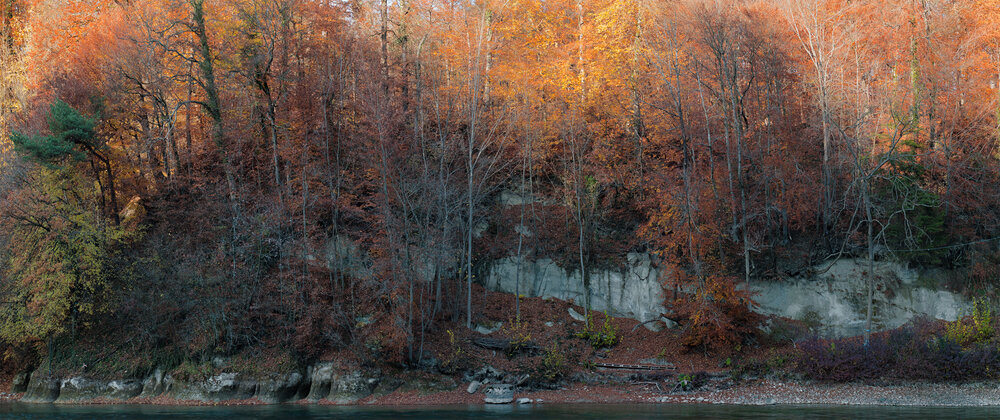In this exhibition we are treated to a miscellany of works by photographer/artist Scott Conarroe, produced over the last couple of decades. The theme, trees, is merely nominal in the sense that it does not present itself to the viewer. Indeed, in some of the urban-based photographs in the show there is barely a tree in sight. Trees, as Conarroe puts it, are a leitmotif. Overall the show is retrospective in tenor, insofar as it highlights a selection of images that are the result of a formula he has developed over many years, that he is now moving away from.
Installation view of Scott Conarroe, About Trees at Stephen Bulger Gallery. Courtesy of Stephen Bulger Gallery
The lead picture, that is, the most representative of the theme is “Big Tree & Small Tree, London, ON” that was produced back in 2006. Like many of the prints on display, it is conspicuously rich in colour. It reflects the way in which Conarroe choreographs the lighting. He explains how waiting for the right time of day in this regard is essential to his working method.
Scott Conarroe, Big Tree & Small Tree, London ON, 2006 © Scott Conarroe / courtesy Stephen Bulger Gallery
As well, the viewer quickly notices that the most of the pictures are taken from an elevated point of view, i.e., from up high. Again, Conarroe is careful to search out a highpoint in the landscape – a cliff or building, say, – from which to take his shots. Only after he has done so does he choose and compose his picture. This strategy is perhaps most obvious in his “Pedestrian Walkway, Santa Monica, CA”. Here we see a sandy beach foregrounded by a complex of buildings decorated with palm trees behind it. The viewer would be forgiven for assuming this picture was taken by a drone because of the flatness of the landscape it depicts. In fact the shot is taken from a cliff top, obviously out of sight.
Scott Conarroe, Pedestrian Walkway, Santa Monica CA, 2010 © Scott Conarroe / courtesy Stephen Bulger Gallery
Both his rich colours and elevated vantage point remind me of an iconic work of the American painter Thomas Moran, titled ‘Green River Cliffs, Wyoming’ (1881). This long horizontal painting depicts dramatic sunlit sandstone cliffs. Reputedly Moran built a scaffold from which to make the painting, in order to achieve the same elevated point of view.
In Moran’s case, he deliberately edited out the railway that in fact occupied the site he had chosen. By contrast, Conarroe seeks out landscapes that very often feature the intersection of the natural and the urban, something that has been an abiding theme of his work. But like Moran he has travelled extensively across the continent to make his art. In Conarroe’s case he’s done this to record this intersection. That is especially so in his series of photographs titled ‘by Rail’ and ‘By Sea’ – some of which are featured in this show – that highlight the railways and ports instrumental in the construction of this continent’s ‘civilization’.
Scott Conarroe, Courtyard, Marseille FR, 2012 © Scott Conarroe / courtesy Stephen Bulger Gallery
From his own description of how he works, Conarroe is opportunistic. He is not conceptually driven in that, often he has wandered around the environment he has chosen with an open mind, waiting for something he sees to inspire him to make the effort to stage a photograph. He seems to possess an almost childlike joy in looking at the world, notwithstanding, of course, that his work is not naïve. It has a great deal of sophistication. As a consequence perhaps there is a lack of gravitas to his work. It is more entertainment than poetic. That is to say, it is not very concerned with interpretive depth, instead its primary aim is to be visually interesting. It appeals to the retinal rather than the intellectual, one might say.
Scott Conarroe, Forest Fire Plume, Golden BC, 2008 © Scott Conarroe / courtesy Stephen Bulger Gallery
Photography, of the sort practiced by Conarroe, is inclined to highlight that which is beautiful. As Susan Sontag remarks, regarding this tendency: “It is common for those who have glimpsed something beautiful to express regret at not having been able to photograph it.” (On Photography, p. 85) In other words, we tend to use photography to bring out that which we find beautiful in the world, to capture it. Ditto with Conarroe.
Scott Conarroe, Sunday Morning, Genk BE, 2011 © Scott Conarroe / courtesy Stephen Bulger Gallery
A danger in landscape photography in this regard is that the image is all retinal with little or no conceptual underpinning. By contrast, someone, who like Conarroe is interested in the intersection between nature and the urban, and whose works do illustrate such depth, is the well-known American photographer Robert Adams. In one of his iconic black and white shots the bottom two thirds of the composition details a litter-strewn scrubland to the side of a parking lot, while out of focus in the mid-distance is a diner (Denver, 1973-4). The beauty of the image surprises, and is thus enhanced, by its subject matter.
Scott Conarroe, Aare Bank, Bern CH, 2023 © Scott Conarroe / courtesy Stephen Bulger Gallery
Conarroe’s artistic preoccupations are clearly quite different from Adams’. He is his own photographer no doubt, and a very accomplished one. At their best his photographs are both grand in scope and enchanting, reminiscent of the paintings of the romantic period, such as some of those by Caspar David Friedrich. But a little more conceptual depth to challenge the viewer would not go amiss.
Hugh Alcock
*Exhibition information: Scott Conarroe, About Trees, September 14 – October 26, 2024, Stephen Bulger Gallery, 1356 Dundas Street West, Toronto. Gallery hours: Gallery hours: Tue – Sat 11am – 6 pm.







